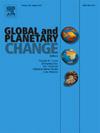A climate of conflict: How the little ice age sparked rebellions and revolutions across Europe
IF 4
1区 地球科学
Q1 GEOGRAPHY, PHYSICAL
引用次数: 0
Abstract
The Little Ice Age (LIA) – lasting from ∼1250 to ∼1860 - was a long period of cooler, drier conditions, characterized by increased climate instability. The most significant climate extremes were more closely associated with interannual temperature variations or particularly severe, isolated cold spells than with prolonged cold spells lasting many years. During this pre-industrial phase of climate instability, many rebellions broke out, one of the most famous being the French Revolution of 1789. A key question, however, relates to the precise and often intricate role of climate in precipitating these widespread uprisings and rebellions that profoundly reshaped human institutions, particularly in the European context. Using data for solar activity, temperature, precipitation, volcanic forcing and the evolution of grain prices, we compared and contrasted the occurrence of rebellions and revolutions across a wide geographical area comprising Europe-Russia-Ottoman Empire with LIA climate and hazards. We find that climate change primarily affected people's livelihoods by reducing harvests, lowering food-resource availability and sharply increasing cereal prices. Climate therefore played a major role in heightening population vulnerability by exacerbating one of the greatest scourges: malnutrition. For the populace, this fuelled social anger towards political authorities for failing to mitigate the impact of climate change. This study primarily reveals that environmental causes did not generate social crises during the LIA but rather triggered a cascade of environmental and human events that interacted, ultimately leading to highly conflictual situations. The LIA serves as a warning to modern political systems, highlighting the necessity to anticipate the consequences of current climate change to mitigate its impact on societies and prevent social unrest and conflict.
冲突的气候:小冰河期如何在整个欧洲引发叛乱和革命
小冰期(LIA)——持续时间为~ 1250年至~ 1860年——是一段较长的较冷、较干燥的时期,其特征是气候不稳定性增加。最显著的极端气候与年际温度变化或特别严重的孤立的冷期的关系比与持续多年的长时间冷期的关系更密切。在这个气候不稳定的前工业化阶段,爆发了许多叛乱,其中最著名的是1789年的法国大革命。然而,一个关键的问题是,气候在促成这些广泛的起义和叛乱(尤其是在欧洲背景下)中所起的精确而复杂的作用。这些起义和叛乱深刻地重塑了人类制度。利用太阳活动、温度、降水、火山强迫和粮食价格演变的数据,我们比较和对比了包括欧洲-俄罗斯-奥斯曼帝国在内的广泛地理区域的叛乱和革命的发生,以及LIA的气候和危害。我们发现,气候变化主要通过减少收成、减少粮食资源供应和大幅提高谷物价格来影响人们的生计。因此,气候在加剧人口脆弱性方面发挥了重要作用,加剧了最大的灾难之一:营养不良。对民众来说,这加剧了社会对政治当局未能减轻气候变化影响的愤怒。本研究主要揭示了环境因素在LIA期间并没有产生社会危机,而是引发了一系列相互作用的环境和人类事件,最终导致高度冲突的局面。LIA是对现代政治制度的警告,强调有必要预测当前气候变化的后果,以减轻其对社会的影响,防止社会动荡和冲突。
本文章由计算机程序翻译,如有差异,请以英文原文为准。
求助全文
约1分钟内获得全文
求助全文
来源期刊

Global and Planetary Change
地学天文-地球科学综合
CiteScore
7.40
自引率
10.30%
发文量
226
审稿时长
63 days
期刊介绍:
The objective of the journal Global and Planetary Change is to provide a multi-disciplinary overview of the processes taking place in the Earth System and involved in planetary change over time. The journal focuses on records of the past and current state of the earth system, and future scenarios , and their link to global environmental change. Regional or process-oriented studies are welcome if they discuss global implications. Topics include, but are not limited to, changes in the dynamics and composition of the atmosphere, oceans and cryosphere, as well as climate change, sea level variation, observations/modelling of Earth processes from deep to (near-)surface and their coupling, global ecology, biogeography and the resilience/thresholds in ecosystems.
Key criteria for the consideration of manuscripts are (a) the relevance for the global scientific community and/or (b) the wider implications for global scale problems, preferably combined with (c) having a significance beyond a single discipline. A clear focus on key processes associated with planetary scale change is strongly encouraged.
Manuscripts can be submitted as either research contributions or as a review article. Every effort should be made towards the presentation of research outcomes in an understandable way for a broad readership.
 求助内容:
求助内容: 应助结果提醒方式:
应助结果提醒方式:


